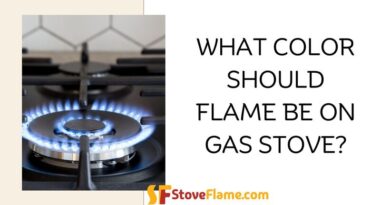What Size Flexible Gas Line for Stove?
When it comes to choosing the right gas line for your stove, size matters. Having the correct size gas line is essential for safe and efficient operation of your stove. With the popularity of flexible gas lines increasing, it is important for homeowners and contractors to understand the factors involved in determining the appropriate size for their stove’s gas line.
This article delves into the key considerations involved in choosing the appropriate size flexible gas line for your stove. This includes understanding the gas pressure requirements, as well as evaluating factors such as line length and diameter. By providing this information, we aim to equip you with the knowledge necessary to make a well-informed decision.
Furthermore, we will explore the various types of flexible gas lines on the market and their respective applications. Additionally, we will highlight essential safety precautions that should be taken into account. By the conclusion of this article, you will have gained a comprehensive understanding of the correct size flexible gas line required for your stove, thereby ensuring a safe and efficient cooking environment.
What is Flexible Gas Line?
A flexible gas line, also known as a gas connector or a gas hose, is a durable and flexible pipe used to connect gas appliances, such as stoves, to the main gas supply. It is made of stainless steel or other materials that are resistant to corrosion and can withstand high gas pressure. The flexibility of the gas line allows for easy installation and adjustments, making it a convenient choice for connecting gas appliances in both residential and commercial settings.
These lines are designed to provide a safe and efficient flow of gas, ensuring that your stove operates effectively. It is important to choose the appropriate size and length of the flexible gas line based on the gas demand of your stove and the distance from the gas source to ensure optimal performance and safety.
Types of Flexible Gas Lines
When it comes to flexible gas lines, there are several types available on the market. One common type is the corrugated stainless steel tubing (CSST), which is known for its flexibility and ease of installation.
Another type is the coated stainless steel line, which has an added layer of protection against corrosion. Additionally, there are flexible copper lines that are highly resistant to heat and can be easily bent to fit tight spaces. Nylon gas lines are also an option, typically used for outdoor applications. Each type of flexible gas line has its own advantages and considerations, so it’s important to choose the one that best suits your specific needs and meets safety regulations.
Differences between Flexible And Rigid Gas Lines
Flexible and rigid gas lines have distinct differences that should be taken into consideration when installing or replacing a gas line for your stove. Flexible gas lines, such as corrugated stainless steel tubing (CSST) or coated stainless steel lines, offer greater flexibility and ease of installation. They can be easily bent and maneuvered to fit tight spaces, making them ideal for situations where rigid lines may be difficult to install.
On the other hand, rigid gas lines, typically made of black iron or steel, provide a more durable and long-lasting solution. They are less prone to damage and have a higher pressure rating, making them suitable for heavy-duty applications.
It’s important to note that rigid lines require precise measurements and careful planning for installation, while flexible lines offer more flexibility but may require additional support and consideration for safety regulations. Ultimately, the choice between flexible and rigid gas lines depends on the specific needs of your stove installation and the regulations in your area.
Understanding Gas Line Sizing
When it comes to understanding gas line sizing, it’s crucial to ensure that you have the right size line for your stove to ensure efficient and safe operation. The size of the gas line is determined by factors such as the BTU (British Thermal Unit) rating of your stove, the distance the gas needs to travel, and the pressure required for proper combustion. It’s recommended to consult with a licensed professional or a qualified gas technician to accurately determine the appropriate sizing for your specific setup.
They will take into account these factors and adhere to local building codes and regulations to ensure a properly sized gas line that meets safety standards. By understanding gas line sizing and seeking professional guidance, you can confidently install a gas line for your stove that provides reliable performance and peace of mind.
Importance of Choosing the Correct Size Flexible Gas Line for a Stove
Ensuring that you choose the correct size flexible gas line for your stove is of utmost importance for several reasons. Firstly, using a gas line that is too small can result in inadequate gas flow, which can lead to your stove not operating at its full potential. This can result in longer cooking times, uneven heat distribution, and ultimately, frustration in the kitchen.
On the other hand, using a gas line that is too large for your stove can lead to excessive gas flow, which not only wastes energy but can also pose a safety risk. It’s important to remember that the correct size gas line will ensure that your stove receives the appropriate amount of gas pressure, which is essential for efficient and safe operation. By choosing the right size flexible gas line, you can optimize the performance of your stove, enhance your cooking experience, and most importantly, prioritize the safety of your home and loved ones.
What Size Flexible Gas Line for Stove?
Typically, a 1/2-inch supply line is sufficient for a gas cooktop requiring 45 CFH, delivering a capacity of 56 CFH, slightly exceeding the necessary amount. If a gas oven is also used, totaling 75 to 80 CFH, a 3/4-inch diameter line would be appropriate.
Factors to Consider When Choosing a Flexible Gas Line
When choosing a flexible gas line for your stove, there are several factors you should consider. First and foremost, you need to ensure that the gas line is compatible with the type of gas you will be using. Natural gas and propane have different pressure requirements, so it’s important to select a gas line that can handle the specific gas you plan to use.
Another factor to consider is the length and location of the gas line. If your stove is located far away from the gas source, you may need a longer and larger diameter gas line to maintain proper gas pressure.
Additionally, it’s important to choose a gas line that is made from high-quality materials and meets safety standards. Look for gas lines that are certified by recognized organizations and have been tested for durability and reliability.
Finally, it’s always recommended to consult with a professional or a licensed plumber to ensure that you choose the right size and type of flexible gas line for your stove. They can assess your specific needs and provide expert advice to ensure the safety and efficiency of your gas line installation.
Recommended Sizes for Different BTU Ranges
When it comes to selecting the right size flexible gas line for your stove, it’s essential to consider the BTU (British Thermal Unit) range of your appliance. BTUs are a measurement of heat output, and different stoves have varying BTU requirements.
For stoves with a BTU range between 20,000 and 30,000, a 1/2-inch gas line is typically sufficient. Stoves with a BTU range between 30,000 and 40,000 may require a 3/4-inch gas line to ensure proper fuel supply. If your stove has a higher BTU range, such as 40,000 to 50,000, a 1-inch gas line is recommended.
However, it’s important to note that these are not fixed sizes, and it’s always best to consult with a professional or a licensed plumber to determine the most appropriate gas line size for your specific stove and installation.
Installation and Safety Tips
To ensure a safe and successful installation of a flexible gas line for your stove, there are a few important tips to keep in mind. First and foremost, it’s crucial to turn off the gas supply at the main valve before starting any installation work. This will prevent any gas leaks or potential accidents.
Additionally, always use a high-quality and properly sized gas line that is designed for use with natural gas or propane. Avoid using old or damaged gas lines, as they can pose a safety risk. When connecting the gas line to your stove, make sure to use appropriate fittings and connectors that are compatible with your specific appliance.
It’s also recommended to check for any leaks after installation by applying a solution of soapy water to the connections and looking for any bubbles. Lastly, if you’re not confident in your installation skills, it’s always best to hire a professional to ensure a safe and reliable setup. Remember, safety should always be the top priority when working with gas lines.
Double Check For Leaks Before Use
Before using your flexible gas line for your stove, it’s crucial to double check for any potential leaks. This is an important step to ensure the safety of your home and prevent any gas-related accidents. Start by inspecting all the connections and fittings, making sure they are properly tightened and secure.
Then, use a solution of soapy water and apply it to the connections. Look closely for any bubbles or signs of gas escaping, as this indicates a leak. If you notice any leaks, it’s essential to address them immediately by tightening the connections or replacing any damaged parts. Remember, taking the time to double check for leaks before use can save you from potential hazards and give you peace of mind knowing that your gas line is functioning safely.
Final Words
In conclusion, ensuring the appropriate size of flexible gas line for your stove is crucial for the safe and efficient operation of your appliance. By considering the BTU range of your stove and following the recommended guidelines for gas line sizes, you can maintain optimal fuel supply and prevent potential safety hazards. Taking the time to assess and select the correct gas line size demonstrates a commitment to both the functionality and safety of your stove, ultimately contributing to a smooth cooking experience in your kitchen.
I'm Daniel Miller, the proud owner of StoveFlame. With over five years of experience in this dynamic field, I've honed my skills and passion for delivering top-notch quality and accuracy in everything I do.





